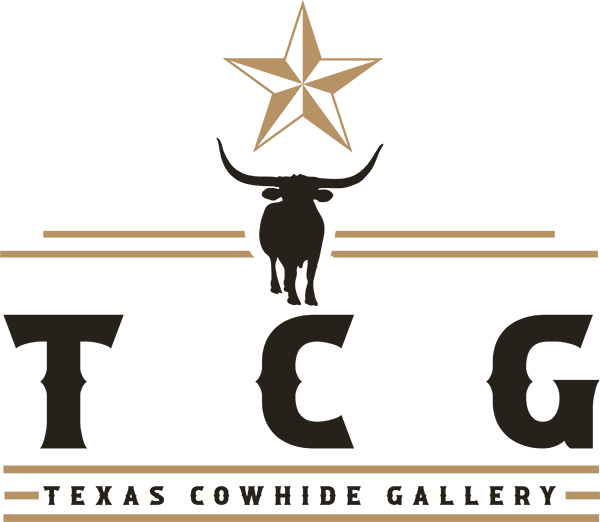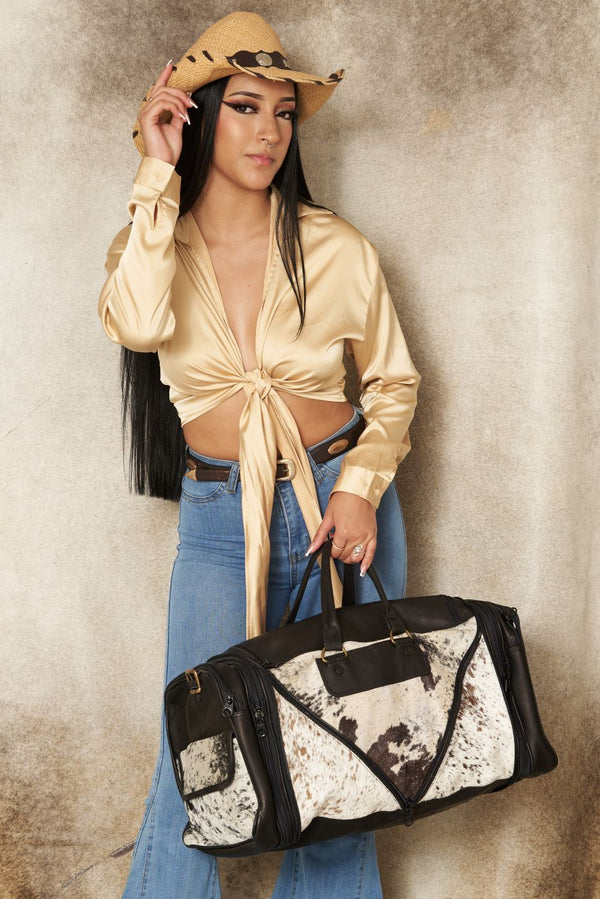Cowhide, often overlooked in favor of more exotic and luxurious materials, is a natural wonder that boasts a unique and timeless beauty. It's an embodiment of rustic elegance, showcasing the distinct characteristics of the animals from which it's sourced. As we delve deeper into the world of cowhide, we discover a material that not only epitomizes natural beauty but also possesses remarkable versatility and sustainability.
The Origin of Cowhide
Cowhide can be defined as the natural and unaltered skin of cattle, which primarily originates from the cattle industry, where cows are raised for meat and dairy production. This industry plays a pivotal role in the food supply chain, providing meat for human consumption. When cattle reach maturity, they are processed for their meat, yielding various cuts and products. Cowhide, however, is a valuable byproduct of this process, representing the animals' hides. If not utilized, these hides would go to waste. The hides undergo an essential tanning process to transform them into a suitable material for various applications, such as leather and cowhide products.
This process involves treating the hides with chemicals to prevent decomposition and to achieve the desired texture, color, and durability. Processed cowhide is used in an array of products, including cowhide rugs, upholstery, fashion accessories, and furniture, thanks to its natural beauty, durability, and versatility. Furthermore, the use of cowhide is environmentally responsible, as it ensures that no part of the animal goes to waste, contributing to the sustainability of the cattle farming industry.
The Beauty of Variation

The beauty of cowhide lies in its remarkable and captivating variation. Unlike synthetic materials or even other natural fabrics, cowhide boasts a unique charm stemming from its individuality. Every piece of cowhide is a one-of-a-kind creation, and this natural variation sets it apart from other materials.
One of the most striking aspects of cowhide is the diversity of patterns, colors, and markings that can be found within each piece. No two cowhide rugs, upholstery, or accessories are identical. This diversity can be attributed to the individuality of the animals from which the hides are sourced. Factors such as the breed, age, diet, and environmental conditions these cattle experience throughout their lives play a role in shaping the distinct characteristics of their hides.
From bold stripes and speckled patterns to intricate marbling and unique color combinations, cowhide showcases nature's artistry in a way that cannot be replicated by human hands. This inherent variation means that when you incorporate cowhide into your decor or fashion, you're adding a touch of nature's beauty and diversity to your surroundings.
Durability and Resilience
Image alt text: a dual toned cowhide rug
Aside from its aesthetics, cowhide boasts remarkable durability and resilience. The durability of cowhide can be attributed to its origin as the skin of cattle, which is naturally robust and built by nature to endure various environmental conditions. This natural toughness gives cowhide an edge in terms of longevity. Whether used as a luxurious cowhide rug in a high-traffic area, as upholstery for furniture that sees daily use, or as a stylish fashion accessory, cowhide consistently proves its capacity to endure.
Cowhide's resistance to stains and its ease of cleaning contribute significantly to its practicality and longevity. Accidental spills are a common concern in everyday life, but cowhide is known for its ability to repel liquids, allowing for easy cleanup. Simply blotting with a clean cloth is often sufficient to address spills, and harsh chemicals or abrasive cleaners are typically unnecessary.
Moreover, cowhide's strength is highlighted further in its role as upholstery material. When used to cover furniture, cowhide can withstand the rigors of daily use, making it an excellent choice for sofas, chairs, and ottomans. It resists wear and tear, punctures, and abrasions, ensuring that it remains not only aesthetically pleasing but also functional for an extended period.
In the realm of interior design, cowhide rugs are celebrated for their longevity. Placed in high-traffic areas, they maintain their beauty and structure despite constant foot traffic, proving that cowhide is a material designed for resilience. Furthermore, the unique patterns and textures of cowhide continue to shine through, adding character and warmth to any space for years to come.
Sustainability and Eco-Friendliness

In an era where sustainability is a pressing concern, cowhide offers a responsible choice for eco-conscious consumers. Cowhide is a byproduct of the meat and dairy industry, meaning it doesn't require the raising of animals solely for their hides. This sustainable practice helps reduce waste and the environmental impact of cattle farming.
Furthermore, cowhide's durability reduces the need for frequent replacements, which can contribute to a greener and more eco-friendly lifestyle. By choosing cowhide, you're not only embracing natural beauty but also promoting sustainable and responsible consumption.
The Versatility of Cowhide
Cowhide's natural beauty extends to its versatility. From cowhide rugs and upholstery to fashion accessories and wall art, the possibilities are endless. Here are a few ways cowhide can be incorporated into your life:
- Leather Goods: Cowhide is perhaps most commonly associated with leather products. It is used to create an array of items, including belts, wallets, bags, and jackets. Its robust nature ensures that leather goods remain functional and stylish for an extended period.
- Footwear: The use of cowhide in making shoes, boots, and other types of footwear is prevalent due to its strength and resistance to wear and tear. These products offer both comfort and longevity.
- Furniture: Cowhide is a favored material for furniture upholstery, as it offers a unique texture and luxurious appearance. Cowhide-covered chairs, sofas, and ottomans radiate sophistication and elevate interior design.
- Rugs and Carpets: Cowhide rugsare highly sought after for their distinctive patterns and durability. These rugs can complement various design styles, from traditional to modern, and can be used in homes and offices alike.
- Fashion: Cowhide is often used in the fashion industry for clothing items such as coats, vests, and even skirts. Its natural texture and patterns make it a stylish choice for those looking to make a statement with their attire.
- Accessories: Cowhide is also utilized for creating fashionable accessories such as hats, gloves, and scarves. Its supple texture ensures these items remain comfortable to wear.
- Home Decor: Cowhide productsextend to home decor items like throw pillows, table runners, and even lampshades. These accents add warmth and elegance to living spaces.
- Automotive Upholstery: Many high-end cars feature cowhide leather upholstery for their seats and interior trims. Cowhide is appreciated for its comfort and the luxurious ambiance it creates in vehicles.
- Sports Equipment: The robustness of cowhide makes it suitable for sports equipment like gloves and protective gear. Baseball gloves, for example, often use cowhide leather for its durability and flexibility.
- Bookbinding: Cowhide leather has been historically used for bookbinding, lending an air of sophistication and timelessness to books, journals, and other reading materials.
- Equestrian Gear: Cowhide is a primary material for crafting saddles, bridles, and harnesses due to its sturdiness and ability to withstand the rigors of horseback riding.
- Industrial Applications: Cowhide productsare also used in industrial settings, such as welding gloves, safety clothing, and equipment covers, where protection and durability are essential.
Caring for Cowhide
To maintain the natural beauty and longevity of cowhide, proper care is essential. Here are some tips to help you keep your cowhide items in excellent condition:
- Regular Cleaning: Start by gently brushing off any loose dirt or dust with a soft, dry cloth or a soft-bristle brush. Regular cleaning prevents the accumulation of grime, which can lead to premature wear.
- Spot Cleaning: In case of an accidental spill, blot the affected area at the earliest with a clean, damp cloth. Avoid rubbing, as this can not only damage the material but also spread the stain. Use a mild leather cleaner if necessary, following the product's instructions.
- Conditioning: Apply a leather conditioner to keep the cowhide supple and prevent it from drying out and cracking. Make sure to choose a conditioner appropriate for the specific type of cowhide you have.
- Protection from Moisture: Cowhide is susceptible to water damage, so avoid exposing it to excessive moisture. If your cowhide item gets wet, allow it to air dry at room temperature and avoid direct heat sources.
- Sunlight Protection: Prolonged exposure to direct sunlight can cause cowhide to fade and become brittle. Store or display your cowhide productsaway from direct sunlight when not in use.
- Storage: When not in use, store your cowhide items in a cool place, free of moisture. +Keep them away from extreme temperatures, as excessive heat or cold can cause the leather to warp or crack.
Final Thoughts
Cowhide is indeed a material that has withstood the test of time and has gained popularity not only for its beauty but also for the numerous beneficial properties it possesses. If you, too, desire to invest in quality contemporary calf hide rug, feel free to reach us at Cowhide Gallery. With years of experience in the cowhide industry, our team works tirelessly to craft unique cowhide products, all of which are ethically sourced. Contact our team to learn more about our products.

